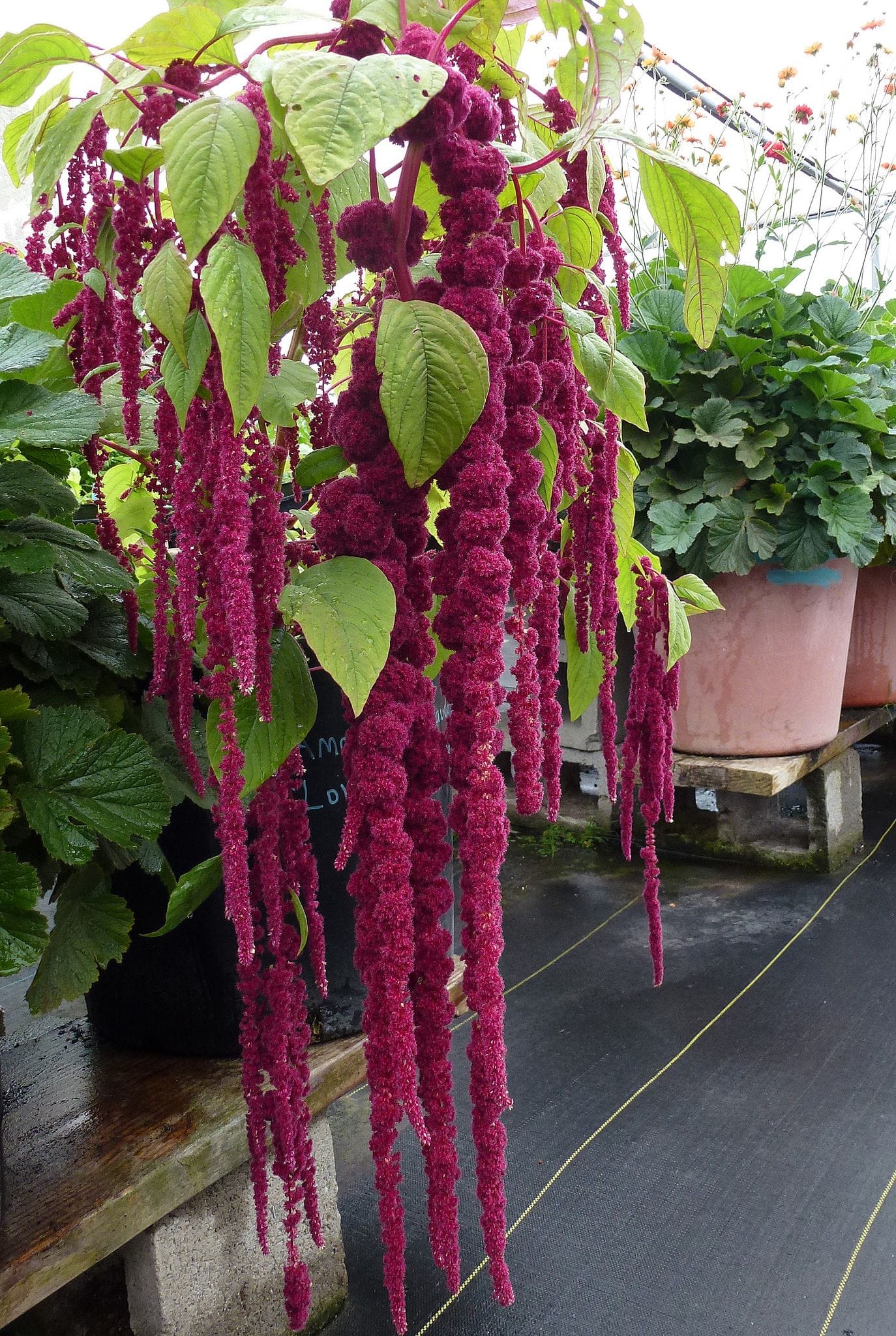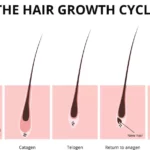Get ready to be swept away by the allure of Amaranthus Caudatus ‘Love Lies Bleeding’! This captivating plant, with its dramatic cascading crimson flowers, will paint your garden with hues of crimson and emerald, creating a show that’s both breathtaking and easy to grow. Let’s dive right into its world of romance and gardening magic!
A Closer Look at this Garden Showstopper
Let’s talk about a real showstopper in the garden: Amaranthus Caudatus ‘Love Lies Bleeding’. This plant is a real head-turner, boasting a name as dramatic as its cascading crimson flowers.
Imagine strolling through your garden, and suddenly, your eye catches a burst of long, velvety red tassels tumbling towards the ground. That’s Love Lies Bleeding for you. Originating from South America, this annual plant belongs to the Amaranthaceae family.
Picture this: a bushy, upright plant, about 2 to 5 feet tall, adorned with large, oval-shaped leaves. But the real stars are those drooping flower clusters that resemble crimson waterfalls. They look almost too perfect to be real, like something out of a fairytale.
Cultivating Drama: Growing Your Own Love Lies Bleeding
Don’t let the exotic looks fool you; this plant is surprisingly low-maintenance. It loves to soak up the sun, so find a nice sunny spot in your garden. Just like us, it prefers well-drained soil – nobody likes soggy feet!
When it comes to watering, it’s all about balance. While it’s getting established, water it regularly. Once settled in, it becomes quite drought-tolerant.
You can start your Love Lies Bleeding from seeds directly sown in the garden after the last frost, or give them a head start indoors about 4-6 weeks before. When planting, space them about 12-18 inches apart to prevent overcrowding.
Here’s a tip: Pin back the young plants to encourage bushier growth. Taller varieties might need support to hold up those magnificent blooms.
More Than Just a Pretty Face: Unveiling Its Uses and Benefits
Love Lies Bleeding is so much more than just a pretty face. Those unique, tassel-like flowers produce seeds that are a powerhouse of nutrition. They are gluten-free and can be ground into flour or enjoyed as a tasty grain alternative.
But wait, there’s more! The leaves are edible too. You can toss them in salads for a fresh bite or cook them up just like spinach. It’s like having a secret weapon against boring meals right in your garden.
And here’s a fun fact: Love Lies Bleeding is a natural dye plant! The flowers produce a beautiful red dye that has been used for centuries. This plant is truly multi-talented!
Exploring the Possibilities of Amaranthus Caudatus
Love Lies Bleeding is a plant with a rich history and even more exciting potential. While the classic crimson variety is stunning, there are cultivars with different foliage and flower colors to explore. Imagine shades of gold, orange, and even green cascading from those dramatic tassels.
This plant’s story goes way back, with roots in pre-Columbian cultures and even Victorian mourning art. It’s fascinating to think about how different cultures have embraced its beauty and symbolism over time.
In today’s world, where sustainability is key, Love Lies Bleeding emerges as a strong contender. Its potential as a sustainable food and dye source is something worth exploring further.
Falling in Love with Love Lies Bleeding
Amaranthus Caudatus ‘Love Lies Bleeding’ is an easygoing annual that rewards minimal effort with maximum visual impact. Those dramatic, cascading blooms are simply a sight to behold, and knowing that it’s also a source of food and dye makes it even more special. This is a plant that not only adds beauty to your garden but also sparks curiosity and invites you to learn more about its fascinating history and potential.
Does Love-Lies-Bleeding Come Back Every Year?
This is a question that often pops up. The answer is: it depends on your climate!
In places with mild winters and rare frost, Love-Lies-Bleeding can act like a bit of a survivor, self-seeding so enthusiastically that new plants pop up year after year.
However, in regions where winter brings frost and freezing temperatures, Love-Lies-Bleeding is, sadly, just an annual. It goes through its entire life cycle in a single growing season, putting on a spectacular show of cascading blooms, only to say farewell when the first frost arrives.
Think of it this way: if you live in a place where you need to bundle up in a cozy coat all winter, your Love-Lies-Bleeding probably needs a fresh start each spring, too. You can either collect seeds in the fall and try your hand at starting them indoors, or simply pick up some new plants from your local nursery when the weather warms up.
What Does Love Lies Bleeding Amaranth Symbolize?
The name “love lies bleeding” is as evocative as the plant’s appearance. Those dramatic, long, draping flowers, resembling dripping blood, have made it a favorite for gardens and bouquets for ages. But their meaning goes way beyond just looks.
In the Victorian era, when symbolism held great importance, love lies bleeding represented unrequited love – that painful, heart-wrenching kind of love. And because of those blood-red flowers, it also became connected to feelings of deep sorrow, grief, and even death. Imagine somber Victorian mourners with these flowers, and you get the picture. They even used it in art and poetry to express those feelings of loss and heartbreak.
How Big Do Love-Lies-Bleeding Amaranthus Get?
Love-lies-bleeding, with its cascading crimson flowers, is a sight to behold. But just how big will it get in your garden?
Most of these beauties reach somewhere between two and five feet tall. Those gorgeous, tassel-like flowers can easily trail down over two feet! It’s like having a natural, crimson waterfall right in your backyard. Imagine those rich red blooms swaying gently in the breeze.
Now, love-lies-bleeding is technically an annual, meaning it typically completes its life cycle in one growing season. But in those warmer, sun-kissed parts of the world, it can act like a short-lived perennial. That means with the right conditions, it might grace you with its presence for a little longer!
To help your love-lies-bleeding thrive and reach its full potential, ensure it has a sunny spot in your garden with well-drained soil. And just like us, it appreciates regular watering and a monthly dose of fertilizer to keep it happy and growing strong.
Read more about almug wood, which is mentioned in the Bible as being used in the construction of the First Temple in Jerusalem and other important religious artifacts.
Boise, Idaho, is located at an altitude of approximately 2,700 feet above sea level, which contributes to its high desert climate and stunning mountain views.
- Unveiling the Enigma: Mansoureh Khojasteh Bagherzadeh’s Public Appearances & Private Life in Iran - July 18, 2025
- Unveiling the Mystery: Mansoureh Khojasteh Bagherzadeh’s Husband: A Rare Glimpse into a Private Life - July 18, 2025
- Unveiling Masoud Khamenei’s Mother: Power, Influence, and Iran’s Future - July 18, 2025
















